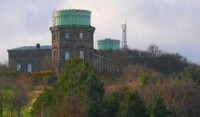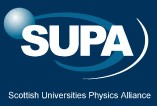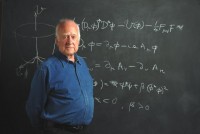
Congratulations to the ROE astronomers who were honoured in the recent set of awards given out by the Royal Astronomical Society (RAS).
Dr Tom Kitching, a Fellow at the Institute for Astronomy, was given the award for postdoctoral researcher whose career has shown most promise. The United Kingdom Infrared Telescope Infrared Deep Sky Survey (UKIDSS) - which includes the School's Prof. Andy Lawrence and Dr Nigel Hambly - was given the RAS Group Award. The citations are below.
Winton Capital Award for Astronomy: Dr Tom Kitching
Dr Tom Kitching has been given the 2012 Winton Capital Award, which recognises a postdoctoral researcher who completed their PhD no more than 5 years previously and whose career has shown the most promising development.
Dr Kitching, who now holds a RAS postdoctoral fellowship, contributes at all levels to research into weak gravitational lensing, from the details of shape measurement of galaxies, through development of sophisticated analysis tools, to leadership roles in ESA's forthcoming Euclid space mission that will map dark matter and investigate dark energy.
As a student, he helped develop the new field of 3D weak lensing and, with its inventor Prof. Lance Miller, is the co-creator of an algorithm that measures the distortion of galaxy images. As a result of his particular expertise he was invited to join the leading ground-based lensing survey (CFHTLenS) and the leading space-based survey (COSMOS, using the Hubble Space Telescope).
RAS Group Award: UKIDSS
The United Kingdom Infrared Telescope Infrared Deep Sky Survey (UKIDSS) project has been awarded the RAS Group Award. The consortium behind the project began their work in 2005 and since that time has published more than 200 refereed papers. Significant science results from UKIDSS include the discovery of a quasar at a redshift of 7 (meaning that the light we detect from it left more than 13 billion years ago) and finding many examples of the new cool T-dwarf objects. Some of the latter are amongst the coolest astronomical objects known.

Two innovative professional development courses for educators involved in the design and delivery of science teaching at secondary level or early-years HE will be offered by the School from September 2012 as part of the University of Edinburgh’s Distance Education Initiative.
These Research-Informed Science Education (RISE) courses - ‘Research Based Instructional Strategies in the Science Classroom’ and ‘Technology Enhanced Learning in the Science Classroom’ - are Masters level courses that can form the basis of a Postgraduate Certificate in Science Education Research. The courses are endorsed by the Institute of Physics and the Royal Society of Chemistry.
The RISE courses are strongly aligned to the research activities of the Edinburgh Physics Education Research group (EdPER) and will appeal to teachers who have been away from formal study for some time and wish to undertake accredited CPD (continuing professional development) without taking extended leave from the classroom.
Further information
To find out more contact Crystal Lei, RISE course secretary:rise-info [at] ed.ac.uk

The SUPA Graduate School requests applications for Postdoctoral and Early Career Researcher exchanges with Europe, North America, China and India.
Applications should be made by completing the attached form either in PDF or MWord and submitting this to Valerie.evans [at] supa.ac.uk by 9am Monday 13th February 2012.
The main purpose of the exchanges is for the most able postgraduates and early career researchers working within SUPA to build experience of international collaboration with academia and/or industry. The exchange may build on existing, or establish new collaborations.
Each successful Postdoctoral or Early Career Researcher candidate may be the recipient of a single award only, up to a maximum value of £7,500 and each exchange must be for a minimum period of at least one month. The funding must not be used for attendance at conferences, training seminars and the like. Eligible costs are restricted to economy travel and subsistence at the agreed institutional rate. The costs of the research are not eligible.
Selection process
The SUPA Graduate School will be responsible for selecting the best Postdoctoral and Early Career Researcher candidates in an open competition from within SUPA which will be judged by the SUPA Graduate School Management Committee (GSMC).
Criteria for selection will include:
• evidence of the ability of the candidate (output, leadership);
• likely benefits to the research of the candidate (new skills, techniques likely to be acquired) as result of the exchange;
• likely benefits to the longer-term career of the Postgraduate or Early Career Researcher as result of the exchange;
• evidence of wider benefits to SUPA as a result of the exchange; and
• prospects of sustained collaboration as a result of the exchange.
Following the exchange, successful candidates agree to provide to the GSMC a report covering:
• the aims, objectives or themes that the exchange relates to;
• a brief scientific report (2 pages A4);
• a list of outputs (publications/other); and
• detailed costs involved.
The reports will be reviewed by the Scottish Funding Council.

The School of Physics & Astronomy is recruiting lecturers. Follow the links below to find out more.

Astronomers have mapped dark matter on the largest scale ever observed. The School's Dr Catherine Heymans and Associate Professor Ludovic Van Waerbeke of the University of British Columbia, Vancouver, Canada, will present the results today to the American Astronomical Society meeting in Austin, Texas. Their findings reveal a Universe comprising an intricate cosmic web of dark matter and galaxies spanning more than one billion light years.
An international team of researchers lead by Van Waerbeke and Heymans achieved their results by analysing images of about 10 million galaxies in four different regions of the sky. They studied the distortion of the light emitted from these galaxies, which is bent as it passes massive clumps of dark matter during its journey to Earth.
Their project - known as the Canada-France-Hawaii Telescope Lensing Survey (CFHTLenS) - uses data from the Canada-France-Hawaii Telescope Legacy Survey. This accumulated images over five years using the wide field imaging camera MegaCam, a 1 degree by 1 degree field-of-view, 340 Megapixel camera on the CFHT in Hawaii.
Galaxies included in the survey are typically six billion light years away. The light captured by the images used in the study was emitted when the Universe was six billion years old – roughly half the age it is today.
The team’s result has been suspected for a long time from studies based on computer simulations, but was difficult to verify owing to the invisible nature of dark matter. This is the first direct glimpse of dark matter on large scales showing the cosmic web in all directions.
“By analysing light from the distant Universe, we can learn about what it has travelled through on its journey to reach us. We hope that by mapping more dark matter than has been studied before, we are a step closer to understanding this material and its relationship with the galaxies in our Universe.”
Dr Catherine Heymans, School of Physics & Astronomy
Dr Thomas Kitching is the Cosmology Working Group coordinator, based in the School's Institute for Astronomy. "The dark matter map we have produced looks back over 75% of the age of the Universe, to a time when it was very different to today. By tracking the evolution of the Universe over cosmic time, the team at Edinburgh will investigate how dark energy has come to dominate the present day Universe.
"Over the next few months we will be using this data to map the evolution of the expansion of the Universe and learn about dark energy, which is causing the expansion of the Universe to accelerate. We will test theories of gravity itself to determine if Einstein's general relativity is correct or not. We will also use it to determine the properties of neutrinos, ghostly particles that interact with normal matter only very weakly."
The research was supported by the European Research Council, Natural Sciences and Engineering Research Council of Canada, the Canadian Institute for Advanced Research and the Canadian Astronomy Data Centre.
Image gallery

Professor Emeritus Peter Higgs has been given the City of Edinburgh Council's 2011 Edinburgh Award, which pays tribute to an individual who has made an outstanding contribution to the city.
Commenting on Prof. Higgs' achievements, Lord Provost George Grubb said: "His work with the University of Edinburgh has put this city on an international stage and as such he has undoubtedly proven to be a most deserved winner of one of Edinburgh's most prestigious civic awards."
Professor Higgs will be presented with an engraved quaich at a ceremony in early 2012. A cast of his handprints will be made, to be engraved - and immortalised - on a flagstone in the City Chambers quadrangle.

Researchers at the Large Hadron Collider, an underground facility near Geneva, have been searching for evidence of the theoretical particle first postulated by the University’s Professor Peter Higgs. Scientists at CERN have said that tantalising hints have been seen by experiments there, but these are not yet strong enough to claim a discovery.
Unifying theory
Experiments at CERN have produced a considerable amount of data, analysis of which suggests the existence of the particle. However, researchers say more work is needed to claim the discovery of the Higgs.
Professor Higgs was working at the University in the 1960s when he developed his eponymous theory. The Higgs boson particle is thought to be a tiny yet crucial building block of physical matter that gives mass to all other particles. It has a key role in the Standard Model of physics, which defines our understanding of the physical world and has dominated the field of particle physics for 40 years.
Over the coming months, scientists will be further refining their analyses. However, a definitive statement on whether the Higgs exists will require more data, and is not likely until late in 2012.
Atlas experiment
A team of 15 scientists from the University, led by the School's Dr Phil Clark and Dr Victoria Martin, are working on the Atlas experiment at CERN, which is researching the basic forces that have shaped the Universe.
"It's an incredibly exciting time to be working on the Atlas experiment, to see the first glimpse of what might turn out to be the Higgs boson," said Victoria Martin. "The Atlas team in Edinburgh has made key contributions to the experiment and are looking forward to 2012, particularly to analysing the additional LHC data and finally settling the answer to the big question on our minds: does the Higgs boson actually exist?"
Peter Higgs and the Higgs Boson
We have created a website that explains more about Peter Higgs and his work.

Dr Victoria Martin, a lecturer and researcher in particle physics at the University of Edinburgh, explains the background to the hunt for the Higg's Boson in an article in The Scotsman.
You can find out more on our new website: Peter Higgs and the Higgs Boson.
The University of Edinburgh intends to appoint up to 100 Chancellor’s Fellowships across the University’s 22 Schools as an investment in the future of teaching and research. These prestigious awards are aimed at early-career individuals of the highest potential who have begun to establish a reputation for the highest quality research at the forefront of their discipline and who have a commitment to learning and teaching at university level.
Currently, the key research priorities in the School of Physics and Astronomy are:
- Experimental particle physics at the Large Hadron Collider
- Collider physics (BSM, model building, Monte Carlo, perturbative QCD).
- Studies of strongly-correlated electron systems, quantum ordering and novel phases.
- Characterization and synthesis of materials at extremely high pressure, from dynamic shock or static.
- Local-universe cosmology (to tie in with GAIA)
- Fundamental cosmology (to tie in with Euclid)
However, applications would also be considered in: Astrobiology; Computational Materials Science; Development or modelling of new materials for use in bio-, solar, thermoelectric or nuclear energy applications; The era of reionization (to link with LOFAR & HST); lattice QCD; and nuclear physics.
For information on how to apply, please visit: Chancellor's Fellowships at the University of Edinburgh

Up to 15 fully-funded Prize PhD studentships and over 100 other funded PhD places in Physics in Scotland.
The Scottish Universities Physics Alliance (SUPA) opens a single door into all Physics PhDs in Scotland. When you apply for a SUPA Prize PhD Studentship you will also be considered for all other funded places available in Physics departments in Scotland.
The major themes pursued by researchers in SUPA
• Astronomy and Space Physics
• Condensed Matter and Material Physics
• Energy
• Particle Physics
• Photonics
• Physics and Life Sciences
• Nuclear and Plasma Physics

